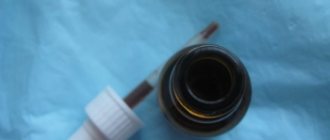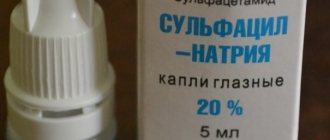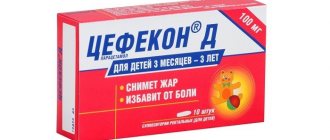A runny nose is a phenomenon that every person has encountered; often it does not escape even infants. For newborns, a runny nose is dangerous because their nasal passages are very narrow and nasal congestion can be life-threatening. That is why at the first symptoms you should fight a runny nose. The long-recognized remedy Protargol is successfully used in pediatrics to this day, including for infants; we will read its instructions for use below.
- Composition and pharmacological actions
- Can it be used by infants?
- special instructions
- Contraindications and side effects
- Storage conditions
Indications for use of Protargol
The range of applications of Protargol is quite wide.
It is used in gynecology, urology, otolaryngology and ophthalmology. Such a wide range of uses is based on the fact that the silver ions contained in it effectively affect gram-positive, gram-negative, anaerobic and aerobic flora. Protargol nasal drops for children and adults are used for:
- Rhinitis or sinusitis (we recommend reading: how to effectively treat sinusitis in a child?). If thick, profuse snot appears, with a characteristic green or yellow tint, the doctor may well prescribe this drug or its full analogue Sialor. Timely use of silver-containing drops can prevent a runny nose with purulent discharge and prevent complications such as otitis media or sinusitis from developing.
- Adenoids. Adenoiditis with accompanying chronic runny nose and inflammation of the nasal mucosa is a reason to prescribe Protargol. Adenoids are dangerous due to their complications. When sick, the patient may have hearing loss, breathing problems, and may lack oxygen. When used correctly, Protargol drops (or any drug of similar action and composition) do an excellent job of drying out the mucous membrane of the tonsils, preventing inflammation and leading to the death of pathogenic microbes. Such a drug can eliminate the need for surgery to remove adenoids (see also: what are adenoids: photos of inflammation in the nose in children).
- Conjunctivitis or blepharitis. Purulent inflammation of the eyelids and eyes is another of those problems that Protargol solution in the form of drops can help cope with.
Having no age restrictions, Protargol is approved for use by adults and newborns. However, it should only be prescribed by a doctor with a prescription. Self-medication is not safe for them.
Purpose of Protargol
This medicine is used by doctors of various specialties - otolaryngologists, ophthalmologists, urologists, gynecologists. In pediatrics, Protargol for infants has found its use in the treatment of the following inflammatory processes:
- conjunctivitis,
- otitis,
- pharyngitis,
- sinusitis,
- sinusitis,
- acute or chronic runny nose,
- diseases of the urethra.
If intolerance occurs, the drug should be stopped immediately. It is also worth considering the fact that the product is very effective against bacteria, but against viruses it is completely powerless.
Contraindications
Protargol is contraindicated for use by people with silver intolerance, women who are breastfeeding, and pregnant women. If taking the drug is necessary during the breastfeeding period, then feeding should be stopped for the period of treatment.
There are also a number of restrictions for newborns. For this age group of patients, the drug is most often used for the prevention of blepharitis. You cannot use Protargol at your own discretion in relation to a newborn child (even with sinusitis); the drug and its dosage with the course of treatment must be prescribed by the attending physician. If the drops are used longer than required, it may have a negative effect on the body.
It is also important that Protargol drops do not act on viral infections, only on bacterial ones
Composition of the drug
The basis of the drug is a chemical compound of silver proteinate with the same name “protargol”. The natural component in the form of a yellow or whitish powder is mixed with proteins and is perfectly absorbed into the mucous membrane. It dissolves well in water to a homogeneous solution.
Until recently, the composition of the drug did not change and did not contain preservatives:
- silver up to 7–8%;
- purified water;
- protein hydrolysis products.
The medicine, according to the classical scheme, is prepared directly in the pharmacy by pharmacologists in a small dose, and is characterized by increased requirements for storage conditions. A modern version of the drug is Sialor Protargol, which is available for self-preparation at home. It has an identical composition to silver.
Protargol instructions for use in children
The drug is used for instillation into the nasal passage, less often - for washing the eyes and bladder. The product is stored in a cool place, so it should be left at room temperature a few minutes before use.
Instructions for use contain the following recommendations:
be sure to rinse your nose with saline solution, water with sea salt or special compositions as prescribed by your doctor; the child lies on his back; a few drops of the drug should be placed into each nostril with a clean pipette; Infants should carefully insert cotton swabs soaked in medicine into the nostril and wipe the mucous membrane with gentle movements.
Protargol - nasal drops for children must be shaken slightly before use so that the solution is more homogeneous.
At what age can you take Protargol?
The drug has a complex and natural composition and does not contain heavy preservatives or toxins. Therefore, many pediatricians recommend their use for infants up to one year old. But in studies of the World Health Organization, there are concerns that the silver content and high dosage may provoke an allergic reaction, angioedema and other unpleasant problems.
There is no consensus on the age at which Protargol can be used. But if there are contraindications, a tendency to seasonal or food allergies, it is better to give the child safer and more proven products. The vasoconstrictor Protargol is not recommended for newborns.
How many times a day can the drug be used?
Unless there are special instructions from the pediatrician, Protargol should be dripped in the morning and evening. First, the nose is freed from mucus accumulation by rinsing. In severe cases of rhinitis or sinusitis, you can additionally use vasoconstrictor drops or a nasal spray to ease breathing. The duration depends on the severity of the disease.
How to dose drops for a runny nose
When calculating the dosage of Protargol drops, the specialist takes into account the child’s age and weight, and his diagnosis. Komarovsky recommends strictly following the recommended volume and not violating the treatment regimen:
- The baby receives the medicine 1 drop 2 times a day. After 6 months, the dose is increased to 2 drops.
- For children over one year old, Protargol 2% solution is dripped 2 drops into the nostril no more than 2 times a day.
- In case of acute inflammation on days 1–3, you can use the drug 3 times a day.
For bacterial rhinitis and sinusitis, the drug is administered 4 drops per procedure. Protargol drops for children are recommended to be used for 5 to 7 days. If no improvement is observed, on the advice of a doctor, the course is extended to 2 weeks.
Protargol nasal drops for children: instructions
The topic of its use in childhood is constantly subject to debate. According to WHO, this drug should not be taken before the age of five due to the fact that allergies may develop. On the other hand, it is the first medicine to prevent blepharitis in newborns.
Although opinions on this remedy differ among different specialists, the advice in this case is simple. If a child has a tendency to allergies, then until the age of 5-6 years it is better to use another substance.
In opposite cases, drops with Protargol in the nose for children are used from any age. At the same time, there is no such thing as children's Protargol, because the drug is prepared in the same way for both children and adults.
The dosage of the medicine depends on the age of the baby and the nature of the pathological process. She is selected by the attending doctor, who takes into account all the nuances of the baby’s illness. So, up to a year, according to the instructions, 1 drop is prescribed, and after 2 years, 2-3.
How to administer the medicine? To do this, you need to clean the child’s nose with a nozzle suction or ask him to blow his nose if the baby already knows how to do this. For greater effectiveness, before the instillation procedure, you can rinse your nostrils with saline solution.
After this, the recommended number of drops is instilled into the child while sitting or lying down.
How many days can a child take this medicine? The standard course of treatment is 7-10 days. If necessary, it can be extended to two weeks.
For babies
Protargol can be used for infants from birth. In some maternity hospitals it is still prescribed for newborns to prevent postpartum blepharitis. It is also used for bacterial rhinitis.
It is worth noting that in children under one year old, cases of allergies to it are much less common than in small patients 2-3 years of age.
During pregnancy
This medicine is not used during pregnancy. It is contraindicated for use in pregnant and lactating women. This is due to the risk of allergic reactions and the lack of data on the effect of the drug on fetal development.
The drug is intended exclusively for local use. A child is prescribed a 1% solution, an adult a 2% solution.
Protargol for children: 1 drop is dripped into each nostril for newborns 2-3 times a day. From 1 to 6 years, 1-2 drops are prescribed in each nasal passage 3 times a day. The maximum course of treatment is 1 week.
After 6 years, Protargol for a runny nose can be used in the form of a spray to irrigate inflamed mucous membranes. To do this, use a special spray nozzle. Do 1-2 injections 3 times a day.
Gargling is prescribed after 3 years. For babies, the oral mucosa is lubricated with a cotton or gauze swab soaked in a 1% solution. Protargol for the throat is not recommended for use in children under one year of age to avoid the medicine getting into the digestive tract.
Protargol for adults, drop 3 drops into each nasal passage 3 times a day, or 5 drops in the morning and evening.
pharmachologic effect
This medication is a combination of proteins and silver. The properties of “Protargol” (nasal drops, despite their effectiveness, have a relatively low cost) are simply unique. With a minimum number of components, the product perfectly protects the nasal mucosa, creating a kind of barrier through which viruses and infections cannot break through. Improvement in the baby’s well-being becomes noticeable the very next day after use.
Drops contribute to the following:
- relieve sensitivity of the inner lining of the nasopharynx;
- inhibit pathogenic microflora;
- constrict the capillaries, which relieves swelling and normalizes breathing;
- relieve the inflammatory process.
In just 5 days of treatment, the baby’s condition noticeably improves. The amount of nasal discharge gradually decreases until it disappears completely. If we compare “Protargol 2 percent” (instructions for children will be presented below) with other medications, then it is safer for the fragile body of children, since it does not have any effect on the intestinal microflora.
How does the children's drug work, how long does it take to see results?
The antibacterial effect of silver ions inhibits the growth of gram-positive and gram-negative bacteria and determines the precipitation of bacterial proteins.
It has an astringent and enveloping effect, constricts blood vessels, reduces the sensitivity of the skin and mucous membranes.
After use, the drug creates a protective film that suppresses and prevents the proliferation of various viruses and bacteria.
With the correct dosage of Protargol, method of application and treatment tactics for runny nose, conjunctivitis, and other diseases, positive dynamics will be noticeable in children already on the second day - swelling and redness will decrease, itching will disappear, the amount of purulent and mucous discharge will decrease.
In particularly severe forms of the disease, improvements are observed only on days 3-4.
If within 7 days treatment with Protargol does not bring relief and the desired effect, you should stop using the drug and consult a doctor for advice.
Action of Protargol
The main active ingredient of these products is silver, presented in the form of active ions that can combine with protein molecules, and is used to achieve two purposes. Firstly, to ensure the main property that Protargol and any of its analogs are characterized by is antimicrobial.
Silver ions actively bind to proteins that make up the framework of bacterial and fungal cells (the agents do not act on viruses and protozoan microorganisms). The more silver that enters the nose in solution, the more actively it affects proteins.
Depending on the concentration of nasal drops, different effects on the microflora are achieved. At a low concentration (1-2% solution), Protargol or its analogue has bacteriostatic properties, that is, it stops cell reproduction. If the concentration is higher, then silver acts bactericidal, stopping all vital processes in bacterial cells and killing them.
The second purpose of using nasal drops with silver is to protect the mucous membrane. The product can bind not only foreign proteins, but also its own, which are part of the mucin, which is produced by the nasal mucosa. As a result, a thin film of denatured protein forms on the surface. With its help, Protargol or its analogue perfectly protects the mucous membrane, since the film isolates the epithelium from the action of microflora. In addition, the production of purulent discharge is significantly reduced.
Indications for use of Protargol
The range of applications of Protargol is quite wide. It is used in gynecology, urology, otolaryngology and ophthalmology. Such a wide range of uses is based on the fact that the silver ions contained in it effectively affect gram-positive, gram-negative, anaerobic and aerobic flora.
Protargol nasal drops for children and adults are used for:
INTERESTING: what harmless nasal drops are there for children: names
- Rhinitis or sinusitis (we recommend reading: how to effectively treat sinusitis in a child?). If thick, profuse snot appears, with a characteristic green or yellow tint, the doctor may well prescribe this drug or its full analogue Sialor. Timely use of silver-containing drops can prevent a runny nose with purulent discharge and prevent complications such as otitis media or sinusitis from developing.
- Adenoids. Adenoiditis with accompanying chronic runny nose and inflammation of the nasal mucosa is a reason to prescribe Protargol. Adenoids are dangerous due to their complications. When sick, the patient may have hearing loss, breathing problems, and may lack oxygen. When used correctly, Protargol drops (or any drug of similar action and composition) do an excellent job of drying out the mucous membrane of the tonsils, preventing inflammation and leading to the death of pathogenic microbes. Such a drug can eliminate the need for surgery to remove adenoids (see also: what are adenoids: photos of inflammation in the nose in children).
- Conjunctivitis or blepharitis. Purulent inflammation of the eyelids and eyes is another of those problems that Protargol solution in the form of drops can help cope with.
Having no age restrictions, Protargol is approved for use by adults and newborns. However, it should only be prescribed by a doctor with a prescription. Self-medication is not safe for them.
INTERESTING: how to use a nozzle ejector for newborns?
Instructions for use
If the child is less than a year old, then use a 1% solution, and for older children you can use 2%. The dosage, duration, frequency of administration, as well as the concentration of nasal drops for a runny nose are determined by the doctor, because they depend on the diagnosis and age of the patient.
For inflammatory eye diseases, for example, conjunctivitis, infants are prescribed 1 to 3 drops per day. For ENT diseases, a small child needs to instill 1 - 4 drops into the nose twice a day. Before treating a child, you must make sure that he is not allergic to this drug. To do this, a test is carried out - one drop of the product is applied to the skin in the elbow area and the result is checked after 15 minutes. If there is itching, redness or other negative reactions in this area, then this drug is contraindicated for the child.
How to properly instill the drug into the nose of infants?
To put Protargol drops into the nose for a runny nose in infants, you must adhere to the following rules:
- the nasal cavity is washed with saline solution, using drops, sprays or saline solution,
- the child’s nostrils are cleaned with a nasal aspirator or a cotton swab,
- the baby is placed on his back, the bottle with the medicine is shaken and the medicine is instilled into each nostril using a pipette,
- This procedure is repeated every day in the morning and evening.
This drug is not addictive, but the duration of treatment should be two weeks, no more, and it is best to limit it to 5 - 7 days. This is explained by the properties of silver, which spreads throughout all organs and settles in them. Its excess amount in the body can cause the development of a rare disease called argyrosis, in which the color of the skin and eyes acquires a silvery tint.
Thus, if a child develops a runny nose caused by an infection, the pediatrician may prescribe a drug such as Protargol. Its versatility is due to its antifungal and antiviral properties. Repeated use is possible only as prescribed by a doctor. In each case, the treatment period and dosage are determined individually.
Features of the drug
Protargol has been used in medical practice for several decades. This drug has both advantages and disadvantages. You should not use it yourself without a doctor's prescription. Infants often experience a functional runny nose that is not caused by viruses or bacteria. It usually appears as a result of drying out the air by heating devices.
The room where the baby is located must be constantly moistened so that the nasal mucosa does not dry out, since drying out causes disease of the upper respiratory tract, because a dry nasopharynx promotes the rapid development of bacteria. Protargol is a medical solution of silver . It does not moisturize the mucous membrane, but, on the contrary, can dry it out a little. Therefore, it is not suitable for restoring moisture in the nasopharynx. This drug is used to treat bacterial and viral runny nose, conjunctivitis, pharyngitis .
Analogs
The antiseptic property is inherent in a large number of drugs of different price categories, but in terms of structural composition it is difficult to find an analogue of Protargol, since drugs based on silver are almost never produced. Doctors recommend the following medications:
Collargol - doctors often advise them to replace Protargol, but care must be taken, since the percentage of silver content here is much higher. Sialor is a popular product that also has antiseptic properties (the main substance is the same active silver ions in a similar concentration), but Sialor is more expensive due to the pipette and the absence of adverse reactions: the lining of the nasal cavity is not irritated.
Contraindications and side effects
The only contraindication is sensitivity to any component of the drug. Adverse reactions can be observed only of a local nature, since the active substance is not absorbed into the blood. These include:
- itching;
- allergic reactions;
- burning;
- irritation.
With prolonged use and exceeding dosages, headaches, dizziness, and dry mouth may occur.
How to use the drug correctly?
In most cases, “Protargol 2 percent” is prescribed for children. The instructions must be issued by pharmacy employees. If for some reason you were given drops without an insert, then you must request one. The course of treatment, dosage, concentration of drops and number of doses is determined by a specialized doctor depending on the disease and age category of the patient. As a rule, one to three drops are prescribed two to four times a day.
Before starting to use the medicine, the baby must be checked for allergic reactions. You can do this yourself at home. Simply apply one drop of colloidal silver to the crook of your elbow. If after a quarter of an hour redness appears on the skin, then “Protargol” nasal drops cannot be used for children.
To achieve the most effective therapy, it is recommended to follow the following rules when instilling:
- The nasal sinuses are pre-washed with saline solution.
- Next, the cavity is cleared of mucus using an aspirator or gauze turunda.
- For instillation, you should use a medicine whose expiration date has not yet expired. In this case, the baby should be placed on his back and the number of drops selected by the doctor should be injected into each nostril.
- The procedure is carried out twice a day.
- For infants, the nostrils are lightly lubricated with cotton wool soaked in the medicine.
Protargol nasal drops for children (the dosage should be determined exclusively by a qualified specialist) are good because, unlike other medications, they are not addictive. However, the duration of treatment should not exceed two weeks. This is due to the fact that silver nanoparticles spread throughout the human body, settling on internal organs, as a result of which an allergic reaction may develop, manifested by a change in the color of the epidermis and eyes. As a rule, seven days of therapy is enough for complete recovery.









